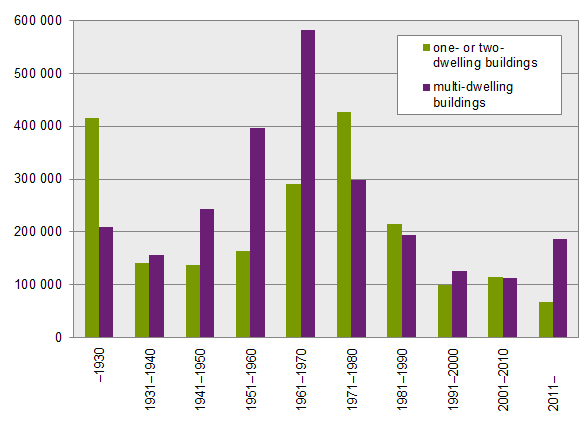Dwelling stock 2018-12-31
Just over 4.9 million dwellings in Sweden
Statistical news from Statistics Sweden 2019-04-25 9.30
At the end of December 2018 there were 4 924 792 dwellings. Among these, 2 081 112 dwellings (42 percent) were in one- or two-dwelling buildings, 2 508 679 (51 percent) were in multi-dwelling buildings, 253 821 (5 percent) were in special housing and 81 180 (2 percent) were in other buildings.
Rented dwellings most common in 257 out of 290 municipalities
In multi-dwelling buildings, rented dwellings are the most common type of tenure, with 58 percent of the total dwelling stock, while 42 percent consist of tenant-owned dwellings. Among the 290 municipalities in Sweden, rented dwellings dominated in 257 municipalities. Only in 33 municipalities are there more tenant-owned dwellings than rented dwellings. More than half of these are located in Stockholm County.
In one- or two-dwelling buildings, private ownership is the most common type of tenure, with 91 percent. The proportion of rented dwellings and tenant-owned dwellings in one- and two-dwelling buildings is 4 percent in each.
Housing cooperatives most common owners of multi-dwelling buildings
With regard to dwellings in multi-dwelling buildings, about 41 percent are owned by housing cooperatives, 27 percent are owned by municipal housing companies and 21 percent are owned by Swedish joint-stock companies. The remaining 10 percent are owned by private persons and other owners.
With regard to one- or two-dwelling buildings, the vast majority (91 percent) are owned by private persons and only 4 percent are owned by housing cooperatives.
Dwellings’ size and age
The average dwelling in multi-dwelling buildings is a flat of two rooms and a kitchen followed by three rooms and a kitchen. These two types make up 68 percent of the housing stock in multi-dwelling buildings.
The average size of a dwelling in multi-dwelling buildings is 68 square metres, while in one- or two-dwelling buildings, the average size is 122 square metres.
Nearly 933 000 (45 percent) of one- or two-dwelling buildings were built between 1961 and 1990. However, one in five houses (or 20 percent) among one- or two-dwelling buildings was built as early as before 1931. With regard to multi-dwelling buildings, most of them (51 percent) were built between 1951 and 1980.

Special housing
There are 253 821 dwellings in special housing in total divided into 135 769 special housing for the elderly/disabled, 99 965 dwellings for students and 18 087 other special housing. The average size of an apartment in a retirement home is 39 square metres, while the average size of a student apartment is 28 square metres. Most student housing can be found, not unexpectedly, in the major university towns.
| Municipality | Number of dwellings |
|---|---|
|
Uppsala
|
11 194 |
|
Göteborg
|
10 889 |
|
Stockholm
|
10 671 |
|
Lund
|
9 450 |
|
Umeå
|
6 305 |
|
Linköping
|
5 070 |
|
Växjö
|
3 939 |
|
Örebro
|
3 668 |
|
Malmö
|
3 041 |
|
Solna
|
2 555 |
Definitions and explanations
These statistics are based on the dwellings register, which is a national register of all Swedish dwellings. This register is managed by Lantmäteriet (the Swedish mapping, cadastral and land registration authority). Statistics Sweden receives data from Lantmäteriet in order to produce current household and housing statistics.
One- or two-dwelling buildings refers to detached one- and two-dwelling buildings, as well as semi-detached, row and linked buildings.
Multi-dwelling buildings refers to buildings with three or more apartments, including balcony access housing.
Other buildings refers to buildings that are not intended for residential purposes but that nonetheless contain regular apartments, for example buildings intended for business or public activities.
Special housing refers to dwellings for the elderly/disabled, student housing and other special housing.
The type of tenure of the apartments is based on ownership, rather than residents’ use of the apartments.
Feel free to use the facts from this statistical news but remember to state Source: Statistics Sweden.
